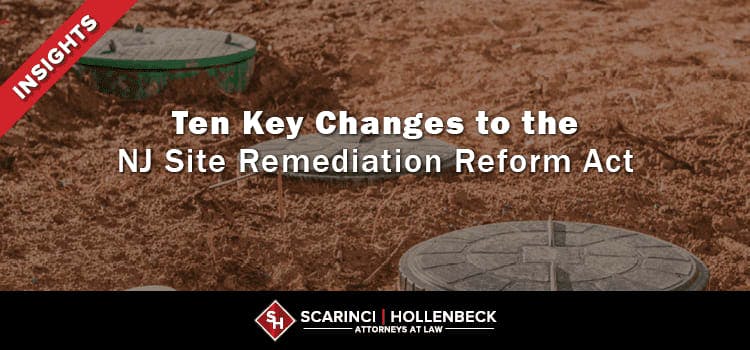
Daniel T. McKillop
Partner
201-896-7115 dmckillop@sh-law.comAuthor: Daniel T. McKillop|September 16, 2019
Governor Murphy recently signed legislation amending the state’s Site Remediation Reform Act (SRRA). The amendments, often referred to as SRRA 2.0, represent the first significant changes since SRRA was enacted a decade ago.

SRRA overhauled how contaminated sites are remediated by creating the Licensed Site Remediation Professional (LSRP) program and shifting the day-to-day oversight of site remediation from the New Jersey Department of Environmental Protection (NJDEP) to LSRPs. SRRA also established an affirmative obligation for persons to remediate any discharge for which they would be liable pursuant to the Spill Compensation and Control Act.
The amendments to SSRA set forth in P.L.2019, c.263 fine-tune SSRA and reflect lessons learned since the statute was enacted in 2009. Below are some of the most significant changes:
(1) Affidavit of Merit: In any action for damages for personal injuries, wrongful death, or property damage resulting from an alleged act of malpractice or negligence by an LSRP, a plaintiff must provide each defendant with an affidavit of merit. Otherwise, the case will be dismissed for failure to state a cause of action.
(2) Remediation Funding: The law amends the requirements governing the establishment of remediation funding sources, including when and how those remediation funding sources may be used, dispersed, and released. In addition, SRRA now allows entities to establish a surety bond from an entity that is listed as an acceptable surety on federal bonds in the United States Treasury Department Circular 570.
(3) Green Practices: The NJDEP must now encourage the use of green and sustainable practices during the remediation of a contaminated site.
(4) Notice to Municipalities: A notice of remediation activity must be provided to the municipalities and counties in which the site is located prior to the initiation of the remedial investigation.
(5) Responding to Public Inquiries: A person responsible for conducting a remediation must respond to any inquiries from the public regarding the status of the remediation. Such response must include either: (1) information or documents that are responsive to the public inquiry; or (2) a written summary status report for the remediation in a form and manner as determined by the NJDEP. A person responsible for conducting a remediation can designate an LSRP to respond to public inquiries.
(6) Reporting Discharges: If an LSRP who is retained to perform remediation at a site or any portion of a site obtains specific knowledge that a discharge has occurred at any location on the site, the LSRP must notify the person responsible for conducting the remediation and the NJDEP.
(7) Immediate Environmental Concerns: The definition of an immediate environmental concern (IEC) is amended to mean “migration of contamination into a structure” producing a toxic or harmful atmosphere or other harmful condition, eliminating that the structure be occupied. However, the amended law also provides that no further remediation relative to an IEC that affects an unoccupied structure is required if a person responsible for conducting the remediation provides to the NJDEP a written certification from the property owner that the building: (1) is not occupied; (2) will not be occupied; and (3) will be demolished.
(8) NJDEP Direct Oversight: The bill amends SRRA’s direct oversight provisions, in most cases making it less likely that the agency will intervene if the responsible party is taking appropriate and timely action. The amendments further provide that when a contaminated site is subject to direct oversight the requirements of direct oversight run with the site regardless of who owns the property and regardless of whether there is a transfer of ownership of the property.
(9) Remedial Action: A person who is issued a remedial action permit for the operation, maintenance, and inspection of engineering or institutional controls and related systems installed as part of a remedial action must retain an LSRP to manage, supervise, or perform the requirements of the permit for the duration of the permit.
(10) Additional LSRP Requirements: The amendments impose additional requirements on LSRPs. Notably, an LSRP may not certify any document submitted to the NJDEP unless the LSRP believes that the information in the submission is true, accurate, and complete. In addition, an LSRP is prohibited from facilitating, aiding, assisting, or cooperating with any person in retaining or arranging for the retention of any person who is not an LSRP to perform remediation, unless the remediation is managed, supervised, or periodically reviewed and evaluated by an LSRP retained for that purpose, and the NJDEP has been notified of the retention.
The amendments became effective immediately upon Governor Murphy signing the bill into law on August 23, 2019. If you have questions or concerns regarding how SRRA 2.0 may impact your operations, we encourage you to contact attorneys of the Scarinci Hollenbeck Environmental & Land Use Law Group.
If you have any questions or if you would like to discuss the matter further, please contact me, Dan McKillop, or the Scarinci Hollenbeck attorney with whom you work, at 201-806-3364.

Partner
201-896-7115 dmckillop@sh-law.comGovernor Murphy recently signed legislation amending the state’s Site Remediation Reform Act (SRRA). The amendments, often referred to as SRRA 2.0, represent the first significant changes since SRRA was enacted a decade ago.

SRRA overhauled how contaminated sites are remediated by creating the Licensed Site Remediation Professional (LSRP) program and shifting the day-to-day oversight of site remediation from the New Jersey Department of Environmental Protection (NJDEP) to LSRPs. SRRA also established an affirmative obligation for persons to remediate any discharge for which they would be liable pursuant to the Spill Compensation and Control Act.
The amendments to SSRA set forth in P.L.2019, c.263 fine-tune SSRA and reflect lessons learned since the statute was enacted in 2009. Below are some of the most significant changes:
(1) Affidavit of Merit: In any action for damages for personal injuries, wrongful death, or property damage resulting from an alleged act of malpractice or negligence by an LSRP, a plaintiff must provide each defendant with an affidavit of merit. Otherwise, the case will be dismissed for failure to state a cause of action.
(2) Remediation Funding: The law amends the requirements governing the establishment of remediation funding sources, including when and how those remediation funding sources may be used, dispersed, and released. In addition, SRRA now allows entities to establish a surety bond from an entity that is listed as an acceptable surety on federal bonds in the United States Treasury Department Circular 570.
(3) Green Practices: The NJDEP must now encourage the use of green and sustainable practices during the remediation of a contaminated site.
(4) Notice to Municipalities: A notice of remediation activity must be provided to the municipalities and counties in which the site is located prior to the initiation of the remedial investigation.
(5) Responding to Public Inquiries: A person responsible for conducting a remediation must respond to any inquiries from the public regarding the status of the remediation. Such response must include either: (1) information or documents that are responsive to the public inquiry; or (2) a written summary status report for the remediation in a form and manner as determined by the NJDEP. A person responsible for conducting a remediation can designate an LSRP to respond to public inquiries.
(6) Reporting Discharges: If an LSRP who is retained to perform remediation at a site or any portion of a site obtains specific knowledge that a discharge has occurred at any location on the site, the LSRP must notify the person responsible for conducting the remediation and the NJDEP.
(7) Immediate Environmental Concerns: The definition of an immediate environmental concern (IEC) is amended to mean “migration of contamination into a structure” producing a toxic or harmful atmosphere or other harmful condition, eliminating that the structure be occupied. However, the amended law also provides that no further remediation relative to an IEC that affects an unoccupied structure is required if a person responsible for conducting the remediation provides to the NJDEP a written certification from the property owner that the building: (1) is not occupied; (2) will not be occupied; and (3) will be demolished.
(8) NJDEP Direct Oversight: The bill amends SRRA’s direct oversight provisions, in most cases making it less likely that the agency will intervene if the responsible party is taking appropriate and timely action. The amendments further provide that when a contaminated site is subject to direct oversight the requirements of direct oversight run with the site regardless of who owns the property and regardless of whether there is a transfer of ownership of the property.
(9) Remedial Action: A person who is issued a remedial action permit for the operation, maintenance, and inspection of engineering or institutional controls and related systems installed as part of a remedial action must retain an LSRP to manage, supervise, or perform the requirements of the permit for the duration of the permit.
(10) Additional LSRP Requirements: The amendments impose additional requirements on LSRPs. Notably, an LSRP may not certify any document submitted to the NJDEP unless the LSRP believes that the information in the submission is true, accurate, and complete. In addition, an LSRP is prohibited from facilitating, aiding, assisting, or cooperating with any person in retaining or arranging for the retention of any person who is not an LSRP to perform remediation, unless the remediation is managed, supervised, or periodically reviewed and evaluated by an LSRP retained for that purpose, and the NJDEP has been notified of the retention.
The amendments became effective immediately upon Governor Murphy signing the bill into law on August 23, 2019. If you have questions or concerns regarding how SRRA 2.0 may impact your operations, we encourage you to contact attorneys of the Scarinci Hollenbeck Environmental & Land Use Law Group.
If you have any questions or if you would like to discuss the matter further, please contact me, Dan McKillop, or the Scarinci Hollenbeck attorney with whom you work, at 201-806-3364.